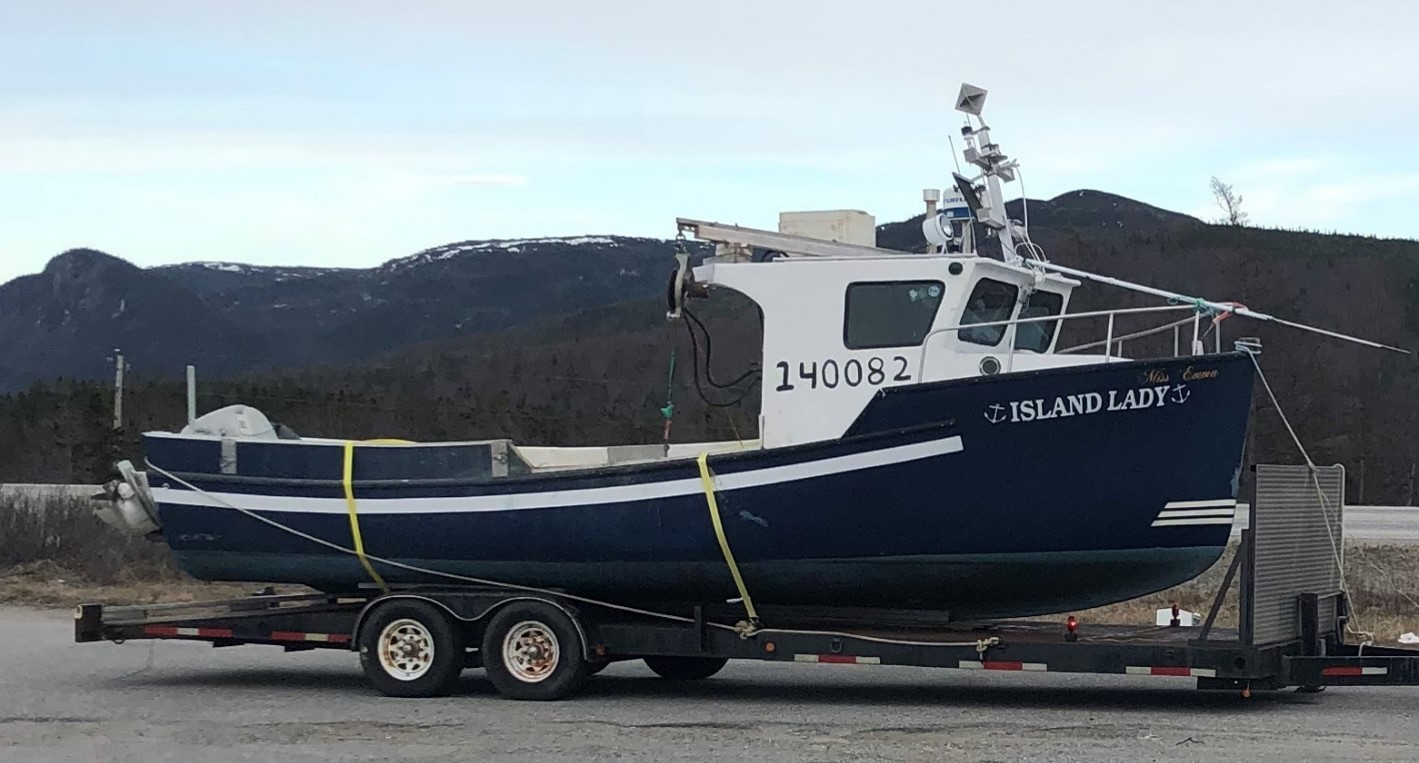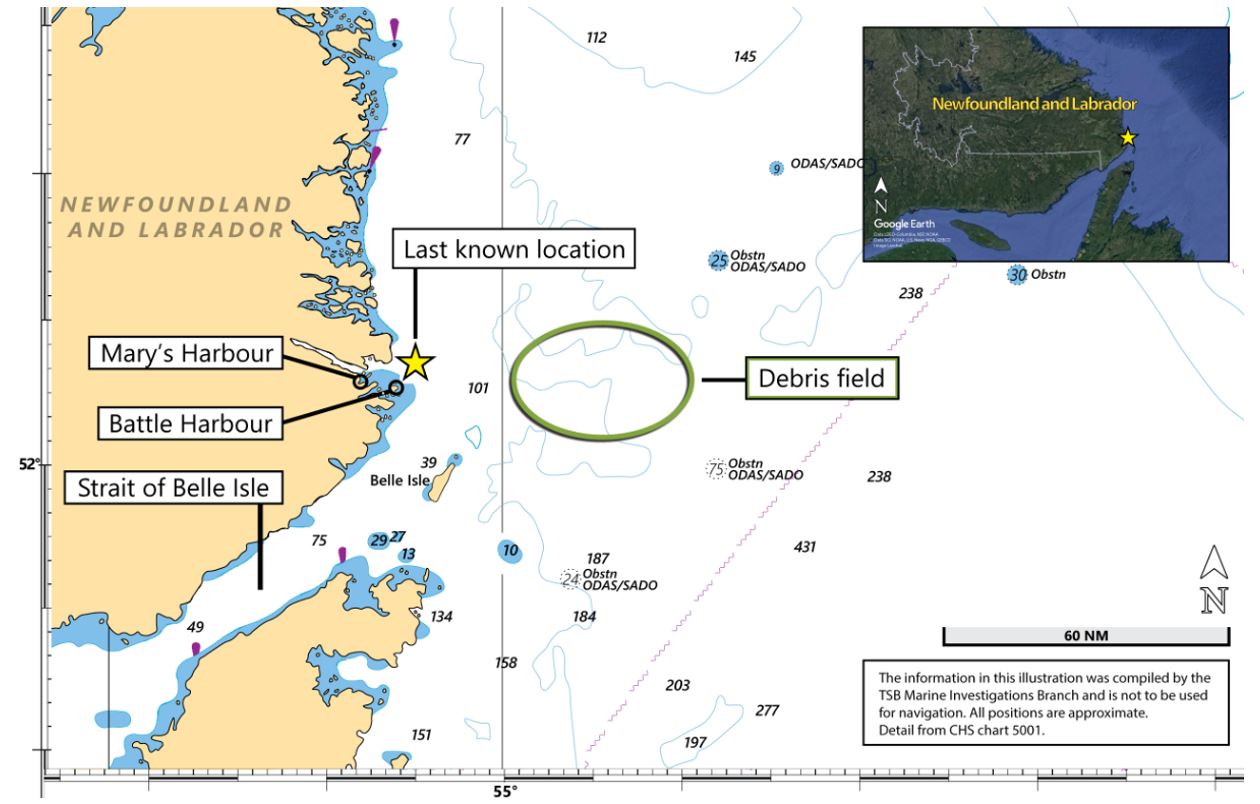Sinking and loss of life
Unregistered fishing vessel known as Island Lady
Labrador Sea, Newfoundland and Labrador
The Transportation Safety Board of Canada (TSB) investigated this occurrence for the purpose of advancing transportation safety. It is not the function of the Board to assign fault or determine civil or criminal liability. This report is not created for use in the context of legal, disciplinary or other proceedings. See Ownership and use of content. Masculine pronouns and position titles may be used to signify all genders to comply with the Canadian Transportation Accident Investigation and Safety Board Act (S.C. 1989, c. 3).
Description of the vessel
The occurrence vessel, commonly known as the Island Lady, was a fibreglass fishing vessel of open construction (Figure 1) that was not registered with Transport Canada (TC). The Island Lady was approximately 8.5 m long, and powered by 2 independent gasoline outboard motors (90 hp each). A hydraulic gillnet hauler was located on the starboard side amidships. The hydraulic pump for this hauler was powered by a gasoline engine installed on the port side on the top of the cabin.
The vessel was equipped with a radar, a GPS (global positioning system) plotter, a satellite phone, and a very high frequency-digital selective calling (VHF-DSC) radio. The DSC function of the VHF radio was not operable, because the radio was not registered with Innovation, Science and Economic Development Canada.Footnote 1
In addition to the fitted equipment, the vessel normally carried 2 insulated fish totes, hand totes containing ice, and spare gas cans. The vessel also carried life jackets, 2 immersion suits, a life ring, and flares.
The voyage
The masterFootnote 2 and one crew memberFootnote 3 departed the fish plant in Mary’s Harbour, Newfoundland and Labrador, at about 0700Footnote 4 on 17 September for the cod fishing grounds (Figure 2). The master’s intentions were to retrieve all of the gillnets and associated catch, ending his 2021 cod fishing operation. When the vessel departed, the winds were variable at 10 to 15 knots, and the morning forecast was for the winds to increase to southwest at 25 knots in the afternoon. The water temperature was reported to be 5 °C.
At about 1200, the vessel was seen south of Battle Harbour, Newfoundland and Labrador. The afternoon forecast had changed to a gale warning, with southwest winds of 25 knots increasing to 35 knots. Shortly after 1600, 2 calls were made using the Island Lady’s satellite phone. One call was received by the local fish plant employee but the conversation was broken and the connection was subsequently lost; the other call was to a friend of the crew member, and a message was left on her answering machine, but the message received was incomprehensible.
At approximately 1830, the master’s father noticed his son was not on social media as was usual near the end of the day. Based on this information, the father initiated a search for the Island Lady. Other harvesters joined the search. At the time the search began, winds were reported as southwest at 25 knots, with 1.5 m seas. The Canadian Coast Guard (CCG) Marine Communications and Traffic Services Labrador overheard discussion about the search on the VHF radios and issued a PAN PAN call. Shortly afterwards, the Maritime Rescue Sub-Centre St. John’s tasked CCG and other search and rescue resources.
The only information available about the area to search was the Island Lady’s position when it was last seen at about 1200 earlier that day. The search involved multiple vessels (fishing vessels, pleasure craft, and CCG vessels) and several aircraft, covering more than 4000 square nautical miles. At about 1100 the next day, the search located debris from the Island Lady, including a fish tote full of cod, 2 hand totes, and some gas cans. Also the next day, local fish harvesters found 4 of the Island Lady’s 14 gillnets on the Battle Harbour wharf.
After 48 hours of searching, the file was turned over to the RCMP as a missing persons case. The search continued for nearly 2 weeks with assistance from the province, fish harvesters, and the CCG. During the search neither the crew or vessel nor the 10 remaining gillnets were found.
The investigation into this occurrence could not determine with certainty the cause of the disappearance of the Island Lady. However, it is likely that the vessel sank and that both crew entered the water unexpectedly, without life-saving appliances for flotation and protection from environmental conditions, and without being able to successfully make a distress call.
Similar occurrences
Between 2015 and 2021, 15 similar occurrences were reported to the TSB, resulting in the loss of life of 34 fish harvesters. In all 15 occurrences, distress alerting devices (e.g., emergency position-indicating radio beacons [EPIRBs] and personal locator beacons [PLBs]Footnote 5) were not used. In 11 of the 15 occurrences, personal flotation devices (PFDs) were not used either.Footnote 6
Vessel stability
Inadequate vessel stability has contributed to a number of fatalities in the past. The TSB’s investigation into the capsizing of the fishing vessel CaledonianFootnote 7 resulted in the Board recommending that
the Department of Transport require that all small fishing vessels undergo a stability assessment and establish standards to ensure that the stability information is adequate and readily available to the crew.
TSB Recommendation M16-03
In response to the recommendation, TC and industry collaborated to develop guidance related to the assessment of stability for fishing vessels.Footnote 8
The Island Lady had never been formally assessed for stability, so the vessel’s inherent stability limits were unknown, and the crew was unaware of the vessel’s safe operating limits.
Registration
Commercial vessels must be registered with TC, even those that are not inspected for certification. Vessel registration with TC is not only a legislative requirement of the Canada Shipping Act, 2001, but also it gives TC the opportunity to provide safety oversight and guidance to vessel owners regarding their responsibility for compliance. In addition, up-to-date registration data mean accurate information is available to search and rescue authorities, and reliable data are available for safety regulators and other organizations in the marine safety system.
The TSB’s investigation into the loss of the fishing vessel Sarah Anne resulted in the Board recommending that
the Department of Fisheries and Oceans require that any Canadian vessel that is used to commercially harvest marine resources have a current and accurate Transport Canada registration.
TSB Recommendation M22-01
The Island Lady was registered with the Department of Fisheries and Oceans as a requirement of the licence to harvest marine resources, but it was not registered with Transport Canada.
Personal flotation devices
Working on deck without wearing a PFD on a fishing vessel is an unsafe practice that has been repeatedly identified by the TSB. Unlike lifejackets, which are designed for use when abandoning a vessel, PFDs are designed to permit users to work without restrictions to movement so they can be worn at all times. However, many fish harvesters are resistant to wearing PFDs, citing issues such as discomfort, the risk of entanglement, and the perception that it is not practical or normal to use them. Furthermore, fish harvesters often underestimate the risk of ending up in the water.Footnote 9
Risk-based regulations and industry initiatives have been developed to help change behaviours and create awareness about the importance of wearing PFDs. PFD manufacturers have also improved PFD design to address fish harvester concerns about comfort and constant wear. However, many fish harvesters continue to work on deck without wearing a PFD, even when one is available.
Life-saving appliances and distress alerting devices
TC has implemented regulations regarding the carriage of life-saving appliances and distress alerting devices in the Fishing Vessel Safety Regulations and Navigation Safety Regulations, 2020. The intent of these regulations is to provide crews with life-saving appliances for protection from the elements in the event a vessel needs to be abandoned, and distress alerting devices that rapidly alert the search and rescue system that a vessel is in distress and provide an accurate location to expedite rescue, minimizing exposure time to the elements.
For vessels like the Island Lady, on a voyage such as was intended the options are to carry life rafts or recovery boats sufficient to carry the number of persons on board or an immersion suit or an anti-exposure work suit for each person on board.Footnote 10 These vessels are also required to carry a VHF-DSC radio capable of transmitting and receiving distress and safety alerts using the DSC function, and either a float-free EPIRB, a manually-activated EPIRB, or a PLB.
Previous TSB investigationsFootnote 11 have found that carrying a distress alerting device can contribute to saving crew members’ lives.
The Island Lady did not carry any operable distress alerting devices. No distress signal was received, delaying the search and rescue response and severely reducing the crew’s chances of survival. On multiple occasions, the absence of such equipment has contributed to preventable fatalities.
TSB Watchlist
The Watchlist identifies the key safety issues that need to be addressed to make Canada's transportation system even safer. Commercial fishing safety has been on the Watchlist since 2010. As this occurrence demonstrates, despite various initiatives under way to enhance the safety culture within the commercial fishing industry, the same deficiencies on board fishing vessels continue to be found.
Safety messages
In an emergency, getting assistance quickly is crucial to fish harvester survival. When combined with life-saving appliances, such as PFDs, a distress alerting device can be an effective means of increasing the chances of surviving an emergency. A fully functioning VHF-DSC radio, an EPIRB, or a PLB can broadcast a signal to indicate the precise location of a vessel or an individual in distress, enabling search and rescue personnel to reach them more quickly.
This report concludes the Transportation Safety Board of Canada’s investigation into this occurrence. The Board authorized the release of this report on . It was officially released on .

